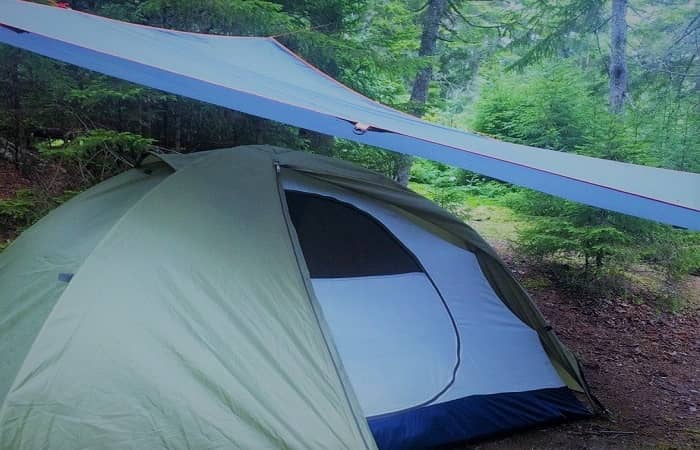How To Make A Rainfly For Tent : Step By Step Guide
In rainy weather, having a rain-fly for your tent is essential since it keeps your tent dry. A rain-fly keeps water from trickling into your tent especially when the weather is extreme with heavy raindrops that have a great impact on your tent.
Installing a rain-fly is very important to ensure it withstands the strong winds and raindrops thus protecting your tent as long as it is necessary. However, when the weather is dry and warm, avoid installing a rain-fly for your tent. This is because it will hinder proper ventilation and make your tent uncomfortable. I will show you how to make a rainfly for a tent.
Contents
Qualities of a good Rain-fly
The best rain-fly is waterproof to ensure water does not soak or drip through into your tent. One challenge however with the waterproofing coating is that it may wear off with time. This calls for you to re-waterproof the rain-fly to see to it that it continues serving you right.

There are several good quality waterproofing tents’ sprays that can make your rain-fly remain water-resistant for quite a long time. Kiwi Camp Dry heavy water repellent and Scotchgard heavy-duty water shield are among the best waterproof you can use to re-waterproof your rain-fly. Scratch-resistant rain flies are better for your tent as they will last longer.
Step by Step setting up a Rainfly for your Tent
When camping or on an adventure for outdoor activities, your tent is very important since it is your house away from home. You there need to have it set on the best location which is safe in different aspects.
To make it more comfortable and provide maximum protection against adverse weather, you may need to have a tarp to keep your tent from getting wet from the dew or groundwater as well as set up a rain-fly to ensure no water drops penetrate your tent. The procedure is simple and for regular camping enthusiasts, this is a DIY activity by following these steps.
- Identify the best location for setting your tent.
- Lay your ground trap and ensure the shiny side is up.
- Let the body of your tent rest on the tarp and check that you align all corners properly.
- Get all the tent poles assembled.
- Attach the poles to the tent and then put all the tent poles into the grommet.
- Once this is done, it is time to put up the rain-fly.
- Ensure the rain-fly rests well on top of the tent body.
- Put the rain-fly into the grommets which lie underneath the tent poles.
- Ensure to align the rain fly door to your tent body door before staking your tent.
- When staking your tent, make sure to tighten the rain-fly so that it is well stretched over your tent. This step is important since it ensures well droplets rollover your tent without settling or infiltrating through into your tent.
- Check to ensure all corners of your tent is well clipped; the rain-fly must be well clipped so that it remains tight even under harsh windy weather. You are good to go now! Fast and simple yet a very quick fix to set up your rain-fly for your tent.
Do All Tents Come with A Rain-Fly?
Many tents come with a complete package with the inclusion of the rain-fly. In such scenarios, the rain fly is tailored to suit the general outlook of your tent. The installation of such a rain fly is much easier and provides a perfect fit.
Contrary, other tents may come without the rain fly or the ground tarp thus you need to purchase one separately and install them to guard your tent body.
In this case, you need to match the rain fly size to the size of your tent to ensure better fitting during installation. Other rain-flies are designed to be fitted over the tent with the help of trees. Here, you simply clip the rain fly over your tent with strong strings to stretch it well ensuring no pool of water forms on the rain fly.
This may become the least option when you go camping in areas with minimal tree cover as setting up the rain fly will be challenging.
Similar Post You May Also Like
What is The Easiest Tent to Set Up by Yourself - Step By Step Tips and Guide
Importance of a Rain-fly
The main benefit you get from having a rain fly over your tent is the protection of water infiltration into your tent. Besides that, a rain fly has other benefits attached to it. You will notice that a tent with a rain fly is warmer than one without. The reason for this is the extra insulation from the cold provided by the rain fly.

The rain-fly also protects your mesh tent windows and doors from strong wind. Small debris such as rocks, sand, and leave materials are kept at bay by the rain fly. Your tent body is safe from UV light thus making it more durable.
Another important detail with a rain fly is that it makes your tent generally stable since the extra stakes and slipping when installing the rain fly. It, therefore, means that besides having the knowledge to install a rain fly, acquiring one is even more beneficial to your tent.
Conclusion
The process of making a rain fly for your tent is quite easy making it a DIY activity for serial adventure persons who enjoy spending their nights out in the wild. Installing the rain fly properly will protect your tent from several dangers especially water penetration into your tent spoiling the fun of camping. Tightening the rain fly is the most important detail that one must keep in mind.
Despite being waterproof, failure to tighten forms a pool of water over your tent. This water is dangerous since accumulation beyond the weight limit will burst your tent or cause other effects. Assemble all the materials needed to set up the rain fly properly when off for camping. If going to camp in new destinations, carry extra clips and strings to set up your rain fly.
Watch The Video To Know How To Make A Rainfly Perfectly For Tent

